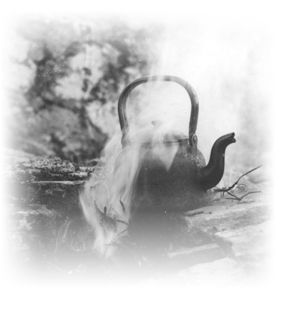Sap
In spring, the birch has sap running under its bark. People used to scrape the sappy layer off with a knife and eat it. Birches can also be tapped by cutting a hole in the bark.
According to T. I. Itkonen, great amounts of sap were in the old days collected in Eastern Lapland from birches, either by carving a hollow in the stump in spring or by making a slit in growing trees by knife. The collecting of sap began at the end of April and went on until mid-June, and it was a women’s and children’s task. Birch sap was drunk as such, but one could also cook gruel or porridge from it by adding flour to it.
Coffee and Tea Surrogates
In the old times, the Sámi used the black conk that grew on the trunk of a birch as surrogate coffee, tea or medicine. The conk is a growth caused by a rot fungus called the clinker polypore, or chaga (Inonotus obliquus). It is the gift of northern nature to people. Clinker polypore causes losses in economical forests because it is a significant saprotroph of birches. On the other hand, decaying wood is important for the biodiversity as it provides a habitat to several forest species.
Coffee became common in Europe in the 1600s at the same time with smoking. Due to commercial policies, several prohibitions were enacted against coffee in the 1700s and 1800s. During the wars, coffee was put on rations every now and then. Mainly, chicory or roasted grain was added to or used as surrogate for coffee in Finland. In the north, people used especially the conks that grew on birches. You could also use the root of the willowherb, dandelion or sea lyme grass for the same purpose. Especially the Skolt Sámi who drank a lot of tea gathered chaga for tea. Such tea was called pakkulatee (“conk tea”). In other parts of Finland this tea was known as tikkatee (“woodpecker tea”).
The clinker polypore is a rot fungus that is found especially in birches but also in other deciduous trees. It sticks – usually in the autumn – to the spots in the trunk that have been damaged, but it is also found in cuts caused by freezing weather. The clinker polypore only rots living wood. The actual sporophores, or fungi, develop between the bark and the core of the tree only after the tree has died. It takes usually 5–7 years from the clinger polypore to kill the tree. The conk created by the polypore has an irregular shape and is crispy and either dark brown or almost coal-black. The clinker polypore is common throughout Finland and cannot be mixed with other polypore species. Especially in the north, it causes a major part of the rot flaws of birches.
The use of chaga is known all over the northern birch zone. Its use in healing probably originated in the east, in Siberia and China. Chaga is also used by the Ainu, the indigenous people that live on Hokkaido in Northern Japan. In Russian and Eastern European folk medicine, chaga tea or extract has been used as treatment for many diseases from gastric ulcer to cancer and skin diseases. The conk abounds in antioxidants and other substances that enhance people’s well-being. It has been verified that chaga strengthens immunity, or the capacity of the body to resist diseases. Because of this, chaga has recently become a popular dietary supplement, source of tea and naturopathic medicine.
Chaga will only have a healing effect if you get it from a living tree. Conks should be taken from the tree carefully, with as little damage to the tree as possible. In the Sámi Area, you can get some conks for your own use on state-owned land but not in the national parks and nature preserves. Elsewhere in Finland, you need permission from the landowner; no permits are granted for gathering chaga mushrooms in conservation areas.
To use the conk, you need to grind it. It’s best to cut it in pieces and grind it while it’s fresh and soft, and then dry the crumbs in a flat bowl. You can use for example a coffee or grain mill for grinding the conk. After the conk has been ground and dried, the powder can be kept in an airtight glass jar or a paper bag. Chaga tea is prepared by boiling a small amount of chaga crumbs in water; after this, the drink is sieved and thinned down, and then sweetened to taste. The taste of chaga reminds of the taste of coffee or tea. Chaga can also be used for other cooking, from soups to milkshakes. For example, try mixing it in the stock of meat soup – it will give the stock an appetizing dark colour!
NOTE! Chaga should not be used at the same time with antibiotics, and those allergic to mushrooms should not use it at all.






